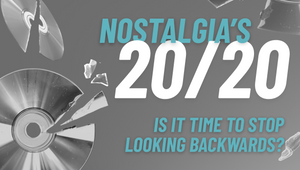
Do We Need to Stop Confusing Retro Cartoon Tech with Innovation?

The future is here, and judging by the past week’s big tech releases, the future is looking pretty indistinguishable from vintage kids TV. Been hankering after the Thunderbirds’ wrist communicator since 1965? Step right up, Apple iWatch. There’s even the rose gold plated $17,000 dollar version if your style leans more Lady Penelope than Brains. But it’s not just tech-infused wrist baubles that are sending early adopters and the media into a retro Saturday morning spin – last week also saw the launch of some of the latest virtual reality headsets to hit the market and the offering from HTC and games company Valve is bringing us a few pixels closer to Star Trek’s Holodeck. And, of course, whosoever can bring 1980s classic Knightmare to VR will earn the respect of the pre-millennial generation.
The world’s tech giants pitch the platforms they hope will go mainstream in the months and years to come in high profile dreams-made-real reveals, but for our industry the practicalities behind the hype are just as important. The novelty of technological innovation isn’t enough and the advertising production community is on a mission to figure out how to turn pieces of increasingly connected kit into meaningful and creative stories and experiences.
On Thursday I headed along to the APA’s Future of Advertising… in One Afternoon at Bafta in London along with people from throughout they city’s production, post and music companies. The event itself covered a broad range of topics and featured speakers from media and creative agencies as well as production, but one strong theme emerged across the talks: technology is exciting but it can’t be allowed to trump creativity. In other words, this industry has amassed a wealth of experience and skills over the years and although the pace and platforms with which we work are evolving we must not forget the principles that makes great work… great.
During the VR panel, which featured Framestore, Unit9 and Happy Finish, the debate turned to the question of whether VR was nothing more than a fad, revived from abortive attempts of the 1990s. But the panellists pushed back and Framestore’s Karl Woolley was adamant that once the novelty of virtual reality subsides, the focus will necessarily, inevitably return to creativity and storytelling. After all, an adrenaline-fuelled action experience like a bungee jump might thrill you once or even twice, but as the tech becomes more mainstream the public is likely to bore of that approach quite quickly.
Havas Media’s Head of Futures, Amy Kean, took to the stage to combine new neuroscientific insights with some old fashioned common sense to suggest that cluttering up the digital landscape with irrelevant advertising and hounding people for likes, clicks and follows was counterproductive, irritating and downright rude. Once again, the message was not to lose sight of our basic humanity in pursuit of the latest technological fad.
Nexus’ Luke Ritchie teased us with some recent innovative projects and guided us through the way that VR and augmented reality and a plethora of cheaply available chips and micro-computers is changing the kind of stories we will be able to tell. His theory was that the mobile had become more of a ‘magic wand’ than a platform and he used examples like Google’s Project Tango (a smartphone that can map out 3D space) and Mozilla’s Web VR to demonstrate how the space around us will soon become a new kind of entertainment screen, one that’s almost inescapable. But even so, the biggest challenge for production companies more used to creating content for flat screens won’t be the technology as much as it will be the ability to create and communicate crafted, engaging and beautiful stories. How, he asked, will a director be able to cede control of the ‘camera’ to the viewer whilst still highlighting and orchestrating the big story ‘moments’?
So by the time Dave Trott arrived with a well-rehearsed seminar on ‘predatory thinking’ and his immutable laws of advertising (inscribed on acetate overhead projector sheets, though, not quite tablets on Mount Sinai), the audience was surprisingly well-primed for his Gestalt-inspired talk (‘stupid people think complicated things are clever’). I’ll admit that when I first glanced at the programme and saw that he’d be talking I wasn’t convinced it was the best fit for an event that’s all about the future, but consider me schooled. (I did, however, later ponder the fact that prey animals with their near-360 field of vision are better able to keep an eye on what’s gone behind them as well as what’s coming up in the future when compared with predators. No matter, I might have missed the point.)
So perhaps it’s kind of fitting that all these apparently new techy toys are so rooted in pop cultural nostalgia. Maybe it’s a sign that we’ve all become so wrapped up in gleaming new pieces of plastic tat that we’ve lost sight a little of what matters. Maybe the treadmill of new tech has forced us to rehash old ideas rather than coming up with (good) new ones? Or maybe we need to start reading some decent books and stop watching old kids cartoons.















